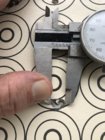Doing all the weighing and precise seating of primers may show up in good conditions. My long answer as to why follows:
In my first post I explained how I didn't do anywhere near the sorting in the mid 2000s that I do know, and yet I shot five screamer groups and set two club agg records at 1000 yds one year. While those groups are not as good now as they were then, I think most LR BR shooters would tell you the LG groups between 3.5 and 4" and aggs under 5" would still win many matches today.
The reason for that is LR BR is a slave to the conditions. No amount of tuning, sorting, and prepping can overcome poor to mediocre conditions. It's only when very good conditions occur that all the intensive sorting show up. Good conditions happen what, 10-20% of the time?
Last October I competed at the NBRSA Long Range Regionals in White City, OR. The day prior to the 1000 yd portion I was able to do some fine tuning of my load at 1000 yds. That day with my 6BRA I shot three consecutive 3-shot groups under 2". They ranged from 1.6 to 1.9". I thought I was well tuned and was going to do very well.
The next two days I shot six five-shot groups and the average was just under 5.4"--which was only good for third place. I was very disappointed, but that is what conditions do. I doubt I would have shot my three sub 2" groups on tuning day without doing all the sorting I do, including the weighing and precise seating of primers. On the two match days I doubt my primer work had any effect.
In the LR BR game, especially at 1000 yds, whoever has the best tuning and sorting usually does the best in good conditions. In average conditions, the finer points don't make as much difference.
Sometimes it can be as simple as the shooter on bench 4 happened to shoot a few seconds later than everyone else and got lucky and caught a good condition that others missed. At the one match I got to shoot this year, I drew second relay (like normal for me) and a storm blew through. Still, I managed to shoot a 1.5" group with my 300 WSM which was small group of the match. All my other groups were all over the place. I just happened to catch a momentary good condition and my rifle shot close to its potential.
So if you want to compete, have fun, and have a good chance in the majority of conditions don't worry about primers. If you want to be competitive in good conditions, do everything you can.
Since I had a 12 year gap in my competing, I am now only in my fifth season. There are others here who have been at it more than I and I would defer to them. Guys like:
@dkhunt14,
@dmoran,
@Jet,
@tom,
@WAMBO,
@Bill Johnston, and some newer shooters who are doing well like
@newbieshooter and
@Keith Faller. That is by no means a complete list, just a few of the guys I know of and/or have shot with that post here.
The tool I like for primer seating is the K&M Primer Gauge. I just started using it and my ES at 200 yd tuning seem consistently a little lower that when I just seated by feel then sorted by measuring. I can now prime two cases a minute the the K&M Primer Gauge. That is slow but since I don't have to do any other sorting and measuring I think the overall time spent is similar to my earlier method.
https://www.grafs.com/catalog/product/productId/7440














